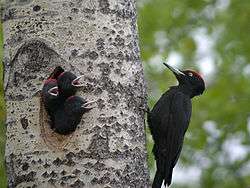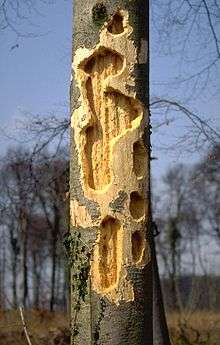Black woodpecker
| Black woodpecker | |
|---|---|
 | |
| Adult male with young. | |
| Scientific classification | |
| Kingdom: | Animalia |
| Phylum: | Chordata |
| Class: | Aves |
| Order: | Piciformes |
| Family: | Picidae |
| Genus: | Dryocopus |
| Species: | D. martius |
| Binomial name | |
| Dryocopus martius (Linnaeus, 1758) | |
| | |
| Black woodpecker range | |
The black woodpecker (Dryocopus martius) is a large woodpecker that lives in mature forest across the northern palearctic. It is the sole representative of its genus in that region. Its range is expanding in Eurasia. It does not migrate. This species is closely related to and fills the same ecological niche in Europe as the pileated woodpecker of North America.
Range
The range of the black woodpecker spreads east from France across the whole of Europe, excluding the United Kingdom and northern Scandinavia. It is also native to parts of Asia, including Korea, Japan and China, and to the Middle East, including Iran and Kazakhstan. The southern limits of this woodpecker's range are in Spain and Italy, and it has also been recorded as a vagrant in Portugal. The species is generally more uncommon and more discontinuous in distribution in the Asian part of its range.[2]
Description
The black woodpecker measures 45 to 55 cm (18 to 22 in) long with a 64 to 84 cm (25 to 33 in) wingspan.[3][4][5] Body weight is approximately 250 to 400 g (8.8 to 14.1 oz) on average.[5][6][7][8] Among standard measurements, the wing chord is 22.7 to 26 cm (8.9 to 10.2 in), the tail is 15.9 to 17.3 cm (6.3 to 6.8 in), the very long bill is 5 to 6.7 cm (2.0 to 2.6 in) and the tarsus is 3.6 to 4 cm (1.4 to 1.6 in).[5] It is easily the largest woodpecker in its range and is second in size only to the great slaty woodpecker amongst the woodpecker species certain to exist, although its average mass is similar to that of the Magellanic woodpecker of South America. The closely related pileated and white-bellied woodpeckers also broadly overlap in size with the black woodpecker, but both are somewhat smaller in average and maximal size and mass.[5][9] The plumage of this crow-sized woodpecker is entirely black apart from a red crown. In males, the entire crown is red, but in females only the top hindcrown is red with the rest of the body all black.[3] The juvenile black woodpecker is similar but is less glossy, with a duller red crown and a paler grey throat and bill .[10] The piercing yellow eyes and manic, high-pitched calls of the black woodpecker have made it the villain of fairy tales throughout its range. Their voice is remarkable in that it has two different calls. One is a short single high-pitched note, a loud, whistling kree-kree-kree, done only twice in a row. The other is a screech-like shrill while in flight. Unlike other woodpecker species, the black woodpecker does not have a dipping, bounding flight but instead flies with slow, unsteady-seeming wing beats with its head raised.[5][10]
Habitat
The black woodpecker is mainly found in forested regions, with a preference for extensive, mature woodland, including coniferous, tropical, subtropical and boreal forests. It is very widespread throughout mountainous and lowland forests. It is more likely to occur in marginal woods near human habitations during the non-breeding season. This species has been observed at elevations between 100 and 2,400 m (330 and 7,870 ft).[2][5][10]
Behaviour

The woodpecker feeds by using its bill to hammer on dead trees to dig out carpenter ants and wood-boring grubs.[11] The selection of foods is relatively predictible, narrow and consistent in this species.[12] Like all woodpeckers, this species has a specially adapted neck containing very strong muscles, which allow it to endlessly hack away at tree bark. Due to the size of its bill and large size and great physical power of this bird, it can access prey fairly deep within a tree. In order to position itself correctly, it has short, stumpy legs, as well as long, sharp claws and very stiff tail feathers. The woodpecker will more than likely choose a tree with a fungal disease, such as heart rot, although some will utilise a living, healthy tree. Once a hole has been made, the black woodpecker chips downwards through the trunk of the tree, creating a nesting chamber, the only lining being the woodchips created throughout the process. The black woodpecker’s excavations provide homes for many other species of bird and mammal, and is therefore considered to be a "keystone" species in many of its habitats throughout its range. It not only provides habitats for other species, but also controls populations of wood-boring insects, helping to protect the trees.[10][13]
When the nest is ready, the female lays a single clutch of two to eight eggs, the average being four to six. The nest hole, usually in a live poplar or pine tree.[11] The breeding pair take it in turns to incubate the eggs, also sharing duties of feeding and brooding the chicks once they have hatched. The nestlings may fight their way to the entrance of the nest in order to be fed first. After 18 to 35 days the young black woodpecker will leave the nest, staying with the adults for another week.[5][10]
Mortality and status
The black woodpecker is a fairly widely distributed woodland species and can successfully breed in most areas where extensive woodland is left. At one point, when much of Europe and Asia was deforested, this species declined and in some areas are still struggling today, including the Pyrenees. They normally require mature trees and ample stands of dead trees to be to have a viable breeding population.[14] However, with the restoration of some forested areas, black woodpeckers have increased in some parts of Europe.[12] They are occasionally considered a nuisance species due to their damage to power lines and communication poles and to house, occasionally resulting in woodpecker mortality due to electrocution or being culled by humans.[15] The main cause of nesting failures appears to be predation.[16] Their main natural predator is the pine marten (Martes martes), which feeds on eggs, nestlings and brooding females and then often takes over the nest hole of the woodpecker for its own.[17] Other than the marten, there are notably few known natural predators of black woodpeckers.[18] Western jackdaws (Corvus monedula) are notably regular usurpers of this species nest holes and a potential predator of eggs and small nestlings.[19] A few of the larger birds of prey that can hunt in woodlands may prey on black woodpeckers. Among those recorded are Ural owls (Strix uralensis),[20] Eurasian eagle-owls (Bubo bubo),[21] northern goshawk (Accipiter gentilis),[22] and common buzzards (Buteo buteo).[23]
References
- ↑ BirdLife International (2012). "Dryocopus martius". IUCN Red List of Threatened Species. Version 2013.2. International Union for Conservation of Nature. Retrieved 26 November 2013.
- 1 2 Peterson, R.T., Mountfort, G. and Hollom, P.A.D. (1993) Collins Field Guide: Birds of Britain and Europe. HarperCollins Publishers, London.
- 1 2 The Birds of the Western Palearctic [Abridged]. OUP. 1997. ISBN 0-19-854099-X.
- ↑ http://www.avibirds.com/euhtml/Black_Woodpecker.html
- 1 2 3 4 5 6 7 Woodpeckers: An Identification Guide to the Woodpeckers of the World by Hans Winkler, David A. Christie & David Nurney. Houghton Mifflin (1995), ISBN 978-0395720431
- ↑ http://www.world-of-animals.de/animal-lexicon/tierart_black-woodpecker.html
- ↑ Rolstad, J. r.; Rolstad, E.; Sæteren, Øy. (2000). "Black Woodpecker Nest Sites: Characteristics, Selection, and Reproductive Success". The Journal of Wildlife Management. 64 (4): 1053–1066. doi:10.2307/3803216. JSTOR 3803216.
- ↑ Brazil, M. (2009) Field Guide to the Birds of East Asia: Eastern China, Taiwan, Korea, Japan and Eastern Russia. A&C Black, London.
- ↑ http://woodpeckersofeurope.info/?q=black_woodpecker
- 1 2 3 4 5 Perrins, C.M., Attenborough, D. and Arlott, N. (1987). New Generation Guide to the Birds of Britain and Europe. University of Texas Press, Texas.
- 1 2 Rolstad, Jorund; Rolstad, E.; Sæteren, Øy. (2000). "Black Woodpecker Nest Sites: Characteristics, Selection, and Reproductive Success". The Journal of Wildlife Management (4th ed.). Allen Press. 64 (4): 1053–1066. doi:10.2307/3803216. JSTOR 3803216.
- 1 2 Mikusiński, G. (1995). Population trends in black woodpecker in relation to changes and characteristics of European forests. Ecography, 18(4), 363-369.
- ↑ Gorman, G. (2008) Central and Eastern European Wildlife. Bradt Travel Guides, Buckshire.
- ↑ Garmendia, A., Cárcamo, S., & Schwendtner, O. (2006). Forest management considerations for conservation of black woodpecker Dryocopus martius and white-backed woodpecker Dendrocopos leucotos populations in Quinto Real (Spanish Western Pyrenees). In Forest Diversity and Management (pp. 339-355). Springer Netherlands.
- ↑ Turcek, F. J. (1960). On the damage by birds to power and communication lines. Bird Study, 7(4), 231-236.
- ↑ Martin, T. E. (1993). Evolutionary determinants of clutch size in cavity-nesting birds: nest predation or limited breeding opportunities? American Naturalist, 937-946.
- ↑ Nilsson, S. G., Johnsson, K., & Tjernberg, M. (1991). Is avoidance by black woodpeckers of old nest holes due to predators? Animal Behaviour, 41(3), 439-441.
- ↑ Paclík, M., Misík, J., & Weidinger, K. (2009, January). Nest predation and nest defence in European and North American woodpeckers: a review. In Annales Zoologici Fennici (pp. 361-379). Finnish Zoological and Botanical Publishing Board.
- ↑ Johnsson, K. (1994). Colonial breeding and nest predation in the jackdaw Corvus monedula using old black woodpecker Dryocopus martius holes. Ibis, 136(3), 313-317.
- ↑ Lundberg, A. (1981). Population ecology of the Ural owl Strix uralensis in central Sweden. Ornis Scandinavica, 111-119.
- ↑ Wassink, G. (2010). Het dieet van de Oehoe in Nederland en enkele aangrenzende gebieden in Duitsland. Limosa. 83: 97-108.
- ↑ Opdam, P., Thissen, J., Verschuren, P., & Müskens, G. (1977). Feeding ecology of a population of Goshawk Accipiter gentilis. Journal of Ornithology, 118(1), 35-51.
- ↑ Šotnár, K., & Obuch, J. (2009). Feeding ecology of a nesting population of the Common Buzzard (Buteo buteo) in the Upper Nitra Region, Central Slovakia. Slovak Raptor Journal, 3, 13-20.
Bibliography
| Wikimedia Commons has media related to Dryocopus martius. |
- Gorman, Gerard (2004): Woodpeckers of Europe: A Study of the European Picidae. Bruce Coleman, UK. ISBN 1-872842-05-4.
- Gorman, Gerard (2011): The Black Woodpecker: A monograph on Dryocopus martius. Lynx Edicions, Barcelona. ISBN 978-84-96553-79-8.
